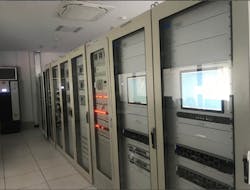A microgrid pilot project is operating in Thailand, marking the first success of a national microgrid policy introduced in 2018.
Commissioned in March, the project serves the energy needs of some 5,000 houses or around 50,000 people in the mountainous Maehongsorn Province in northern Thailand. Developed by Gunkul, the project is called Microgrid Maesarieng. It is an 8 MW development comprising 4 MW of solar PV together with a 1.2 MW hydropower plant, 5 MW of diesel generation and coupled with a 3 MW battery storage system. The microgrid controller and energy management system was supplied by Chinese state-owned Nari Grpor.
The Provincial Electricity Authority (PEA) is responsible for providing electric power and related services and covers the vast majority of Thailand. Under the auspices of Thailand’s Microgrid Development Plan, PEA was selected to take the lead on building the Maesarieng project.
“PEA wanted to develop the pilot project in Maesarieng because this is the area most often affected by outages in Thailand,” Bancha Yathip, assistant project director at Gunkul, explained to Microgrid Knowledge. The main problem is frequent outages where the power line fails or is broken because of flooding, landslides or some other event.
The microgrid project aims to address this reliability issue while the wider Microgrid Development Plan is designed to replace peaking generation in response to power demand growth, reduce distribution losses and overcome constraints in the development of new transmission lines, support growth in renewables, and bolster the development of smart grid technology across the PEA network.
A second microgrid project is also being constructed by Gunkul as part of PEA’s network plans. Set to be developed in BeTong in southern Thailand near the Malaysian border, this 10 MW project comprises a 4 MW battery, 3 MW of solar PV and 5 MW of diesel generation capacity.
“The economics here are positive as energy consumption is in high demand and BeTong recently announced an expansion of the airport, for example. Further growth is anticipated in the future with opportunities also for export into Malaysia and Singapore as well as use in Thailand,” said Yathip.
These latest microgrid developments follow news from earlier this year that Thai energy company Impact Solar is building the country’s largest private-owned microgrid in Sriracha. This 214 MW project will be comprised of gas turbines, rooftop and floating solar as well as a battery storage and control system from Hitachi ABB Power Grids.
“Because of the Thai government policy, there are opportunities for many microgrids to be developed in the country,” Yathip said.
Track news about microgrids worldwide. Subscribe to the free Microgrid Knowledge Newsletter.







